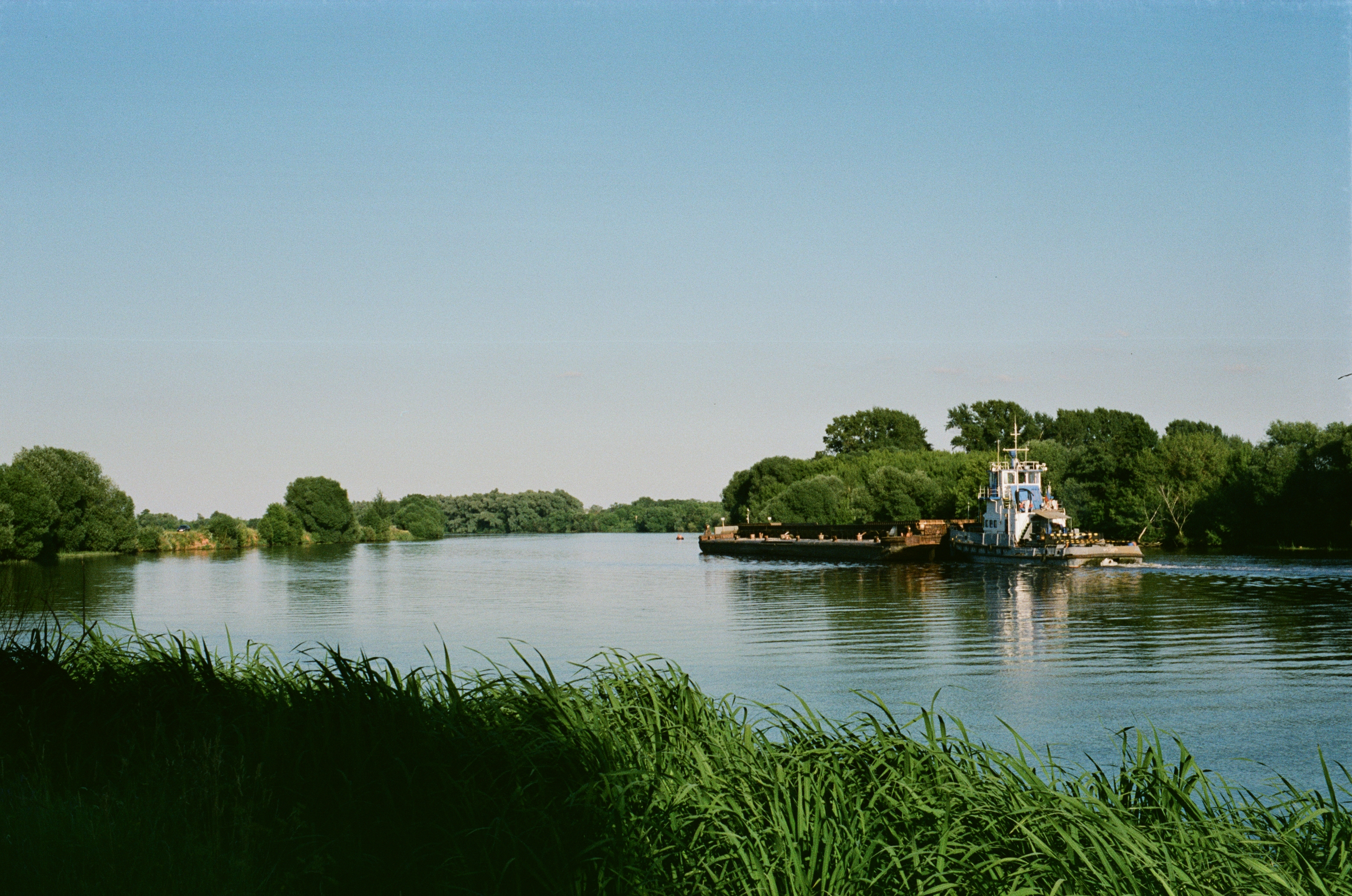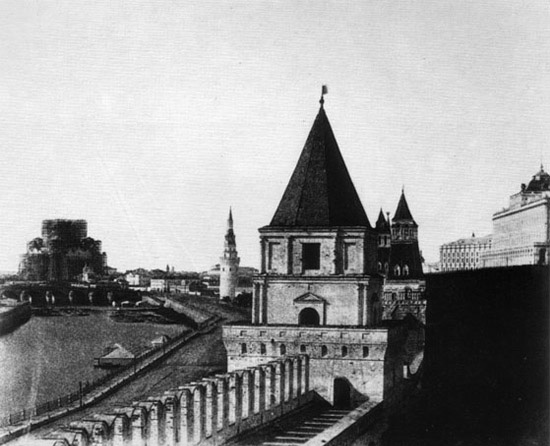|
Patriarshy Bridge
Patriarshy Bridge (russian: Патриарший Мост/Patriarchal Bridge) is a steel pedestrian box girder bridge that spans Moskva River and Vodootvodny Canal, connecting Cathedral of Christ the Saviour with Bersenevka in downtown Moscow, Russia (0.6 kilometers west from the Kremlin). It was built in 2004, designed by . The second part of the bridge spanning Vodootvodny Canal was opened in September 2007. Specifications Length (first part) 203 meters, width 10 meters. Interfax newsreel, 17 June 2005 The very shallow arch is a simple steel box; lace-like "trusses" are for decoration only. Future development Southern end of the bridge right now terminates at the second floor of the future trade complex on Yakimanskaya naberezhnaya which is yet to be built. Also, a new parking in the lower part of the bridge is planned to open. See also ...
|
Wiki Patriarshy 1
A wiki ( ) is an online hypertext publication collaboratively edited and managed by its own audience, using a web browser. A typical wiki contains multiple pages for the subjects or scope of the project, and could be either open to the public or limited to use within an organization for maintaining its internal knowledge base. Wikis are enabled by wiki software, otherwise known as wiki engines. A wiki engine, being a form of a content management system, differs from other web-based systems such as blog software, in that the content is created without any defined owner or leader, and wikis have little inherent structure, allowing structure to emerge according to the needs of the users. Wiki engines usually allow content to be written using a simplified markup language and sometimes edited with the help of a rich-text editor. There are dozens of different wiki engines in use, both standalone and part of other software, such as bug tracking systems. Some wiki engines a ... [...More Info...] [...Related Items...] OR: [Wikipedia] [Google] [Baidu] |
Box Girder Bridges
A box girder bridge, or box section bridge, is a bridge in which the main beams comprise girders in the shape of a hollow box. The box girder normally comprises prestressed concrete, structural steel, or a composite of steel and reinforced concrete. The box is typically rectangular or trapezoidal in cross-section. Box girder bridges are commonly used for highway flyovers and for modern elevated structures of light rail transport. Although the box girder bridge is normally a form of beam bridge, box girders may also be used on cable-stayed and other bridges. Development of steel box girders In 1919, Major Gifford Martel was appointed head of the Experimental Bridging Establishment at Christchurch, Hampshire, which researched the possibilities of using tanks for battlefield engineering purposes such as bridge-laying and mine-clearing. Here he continued trials on modified Mark V tanks. The bridging component involved an assault bridge, designed by Major Charles Ingli ... [...More Info...] [...Related Items...] OR: [Wikipedia] [Google] [Baidu] |
Moskva River
The Moskva (russian: река Москва, Москва-река, ''Moskva-reka'') is a river running through western Russia. It rises about west of Moscow and flows roughly east through the Smolensk and Moscow Oblasts, passing through central Moscow. About southeast of Moscow, at the city of Kolomna, it flows into the Oka, itself a tributary of the Volga, which ultimately flows into the Caspian Sea. History In addition to Finnic tribes, the Moskva River is also the origin of Slavic tribes such as the Vyatichi tribe. Etymology ''Moskva'' and ''Moscow'' are two different renderings of the same Russian word ''Москва''. The city is named after the river. Finnic Merya and Muroma people, who originally inhabited the area, called the river ''Mustajoki'', in English: ''Black river''. It has been suggested that the name of the city derives from this term, although several theories exist. To distinguish the river and the city, Russians usually call the river ''Moskva-reka'' ( ... [...More Info...] [...Related Items...] OR: [Wikipedia] [Google] [Baidu] |
Vodootvodny Canal
Vodootvodny Canal (russian: Водоотводный канал, "water bypass canal") is a 4 kilometre long, 30-60 metre wide canal in downtown Moscow, Russia. It was built in the 1780s on the old riverbed of the Moskva River to control floods and support shipping. Canal construction created an island between the Moskva River and the canal. The island acquired its present shape in 1938 with the completion of Moscow Canal megaproject. The canal is spanned by ten bridges; the eleventh is now under construction. Moscow floods Zamoskvorechye, the land on the flat southern bank of Moskva river, was frequently flooded in spring. The river itself used to migrate south from its present site and back, discouraging construction. Low lands on both sides of the river were only suitable for farming. In dry periods, the old river bed used to shrink into isolated muddy swamps, spreading disease. Residents had to combat inundation levels by digging small moats and dikes, with little result. Th ... [...More Info...] [...Related Items...] OR: [Wikipedia] [Google] [Baidu] |
Cathedral Of Christ The Saviour
The Cathedral of Christ the Saviour ( rus, Храм Христа́ Спаси́теля, r=Khram Khristá Spasítelya, p=xram xrʲɪˈsta spɐˈsʲitʲɪlʲə) is a Russian Orthodox cathedral in Moscow, Russia, on the northern bank of the Moskva River, a few hundred metres southwest of the Kremlin. With an overall height of , it is the third tallest Orthodox Christian church building in the world, after the People's Salvation Cathedral in Bucharest, Romania and Saints Peter and Paul Cathedral in Saint Petersburg, Russia. The current church is the second to stand on this site. The original church, built during the 19th century, took more than 40 years to build, and was the scene of the 1882 world premiere of the ''1812 Overture'' composed by Tchaikovsky. It was destroyed in 1931 on the order of the Soviet Politburo. The demolition was supposed to make way for a colossal Palace of the Soviets to house the country's legislature, the Supreme Soviet of the USSR. Construction starte ... [...More Info...] [...Related Items...] OR: [Wikipedia] [Google] [Baidu] |
Balchug
Island (or Zamoskvorechye) is an area in Moscow. It is made up of an artificial island and is located right across from the Kremlin between the Moskva River and its old riverbed, which was turned into the Vodootvodny Canal in 1786. It does not have any historical, official or established name. In the relevant sources it is referred to simply as the ''Island''. The island a part of the historical Zamoskvorechye area. The island itself was split into four localities: Bersenevka (russian: Берсе́невка), Boloto (russian: Боло́то, swamp), Balchug (russian: Ба́лчуг), Sadovniki (russian: Садовники, after the gardens). Despite the lack of the name proper in some popular publications the island was either referred to by the name of one of the localities on it: Balchug, Bolotny, Sadovnicheskiy or due to its proximity to the Kremlin as Kremlevskiy or due to its land value as Zolotoy (after gold) or simply Bezymyanniy (nameless). [...More Info...] [...Related Items...] OR: [Wikipedia] [Google] [Baidu] |
Moscow
Moscow ( , US chiefly ; rus, links=no, Москва, r=Moskva, p=mɐskˈva, a=Москва.ogg) is the capital and largest city of Russia. The city stands on the Moskva River in Central Russia, with a population estimated at 13.0 million residents within the city limits, over 17 million residents in the urban area, and over 21.5 million residents in the metropolitan area. The city covers an area of , while the urban area covers , and the metropolitan area covers over . Moscow is among the world's largest cities; being the most populous city entirely in Europe, the largest urban and metropolitan area in Europe, and the largest city by land area on the European continent. First documented in 1147, Moscow grew to become a prosperous and powerful city that served as the capital of the Grand Duchy that bears its name. When the Grand Duchy of Moscow evolved into the Tsardom of Russia, Moscow remained the political and economic center for most of the Tsardom's history. When th ... [...More Info...] [...Related Items...] OR: [Wikipedia] [Google] [Baidu] |




